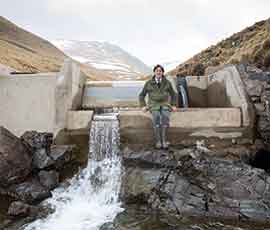Hydro power scheme offers farming potential

Hydroelectricity can be an effective source of power without large reservoirs and damns and should be considered more widely on lowland as well as upland farms, says Oliver Routledge.
“It is possible to generate significant amounts of income from relatively unobtrusive schemes that have little impact on the environment,” says Mr Routledge, who recently installed a 190kW project on his family’s 1,400-acre Scottish sheep and fish farm near Moffat in Dumfriesshire.
The scheme will earn in excess of £100,000 from the Feed-in Tariff (FiT) each year for the next two decades.
Some of the power generated will be used on the fish farm, saving it about £10,000 a year on its electricity bills, a saving that is expected to become more significant as conventional electricity costs rise.
“With fish food now in excess of £1,000/t, creating a stable diversified income stream to support a business that is so beholden to global commodity prices is very exciting and a great step forward for us,” says Mr Routledge.
In addition to the FiTs income and electricity cost savings, power is exported to the national grid and earns an export tariff which is set in legislation and paid by the buyer of the power.
“For smaller schemes this is usually 4.64p/kW, but I have negotiated an initial price of 5.4p/kW with a green energy broker, worth around £45,000 a year,” says Mr Routledge, who also works for land agent Knight Frank’s renewables and energy department.
The £750,000 cost of the hydro electric scheme, which includes the generating equipment and installation of 1,800m of pipes from a burn 170m above the steading, should be paid off within five to six years.
Three years passed between the point at which the decision was made to invest in the scheme to it being installed and working. Two years would usually be a reasonable timescale for an installation of this type, says Mr Routledge, to allow for a year’s water flow monitoring, planning, grid connection, construction and commissioning. It was grid connection complications which held things up in this case.
The amount of untapped hydropower in Scotland is estimated to be the equivalent of 20,000 similar schemes.
FiT payments for renewable technologies are reviewed annually and those for new hydropower schemes are likely to be cut by 2.5 to 5% from April next year.
“Even in lowland areas, there is the potential to install many more small hydro projects. These do not require large differences in height to create a head of water, but rely instead on a higher volume of slower-moving water to power the likes of an Archimedes screw,” says Mr Routledge.
